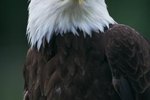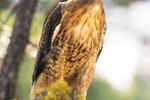
Earth has 59 different species of eagles, according to PBS. The species have varying visual abilities. But every species has visual acuity far superior to that of most other animals—humans included. So, while it might be a compliment to tell a human being she has "eagle eyes," it is an insult to the eagle.
Best of the Animal Kingdom
PBS describes an eagle's vision as among the sharpest of any animal. For example, the wedge-tailed eagle that makes its home in Australia can see twice as far as human beings.That isn't nearly as impressive as many other eagle species. Several eagle species are able to spot rabbits—a favorite prey—as far as 2 miles away and can easily detect the movements of field mice while flying as high as 650 feet above the ground.
Lots of Sensory Cells
An eagle's eyes are densely packed with the sensory cells that detect light and its images and then prepare this information for the bird's central nervous system to interpret. Eagles have as many as a million light-sensitive sensory cells per square millimeter of retina, according to PBS. This is five times the amount allotted to the average human, who has only 2000,000 light-sensing cells per square millimeter of retina.
The Sharper Image
Eagles have two foveae, funnel-shaped sections of the retina where received images are sharpest. Humans and many other bird species have only one of this specialized set of cells. Both foveae in eagles are located in the center of the retina. The second fovea solely processes images coming from the side sections of the eagle's viewing field. This gives the eagle enhanced processing of sideways-sight sensory images.
Three Eyelids
Eagles—as well as other birds—have three eyelids. The inner or third eyelid is not visible from the outside. This nictitating membrane is thin and translucent, and acts like a windshield wiper, sweeping across the bird's eye from side to side. This keeps debris from being lodged in the sensitive tissue. It automatically slides across the eye every three to four seconds, according to the Bald Eagle Information website. This action sweeps away any accumulated dust or dirt. Yet its see-through properties allow the eagle to maintain its visual acuity.
References
Resources
Photo Credits
-
erllre/iStock/Getty Images
Writer Bio
Amy M. Armstrong is a former community news journalist with more than 15 years of experience writing features and covering school districts. She has received more than 40 awards for excellence in journalism and photography. She holds a Bachelor of Arts in communications from Washington State University. Armstrong grew up on a dairy farm in western Washington and wrote agricultural news while in college.




